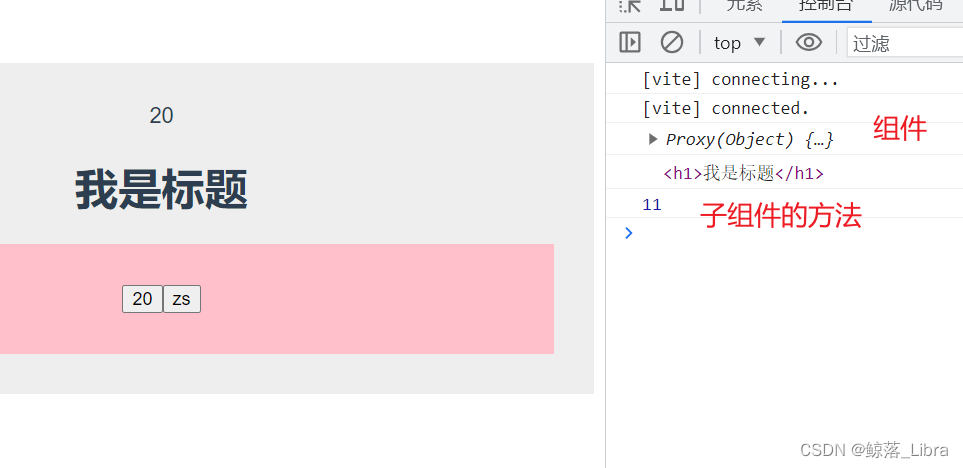
vue3----ref获取组件实例
1.ref获取组件实例时前面不要写冒号
需要注意的是通过ref拿到组件的属性或方法必须是子组件return出来的
具体如下
<!--tempaleteb标签的内容-->
<!-- 注意:ref前面不能有冒号 -->
<h1 ref="title">我是标题</h1>
<child ref="child"></child>
//setup函数内的内容
// 通过ref获取组件实例
const child = ref(null)
const title = ref(null)
//挂载完成后获取实例
onMounted(() => {
console.log(child.value)
console.log(title.value)
child.value.hh()
})
效果图如下

2.组件介绍
Fragment 组件
在 vue2.x 中组件模板必须要一个根标签;但是在 vue3.x 中不再需要一个根标签,它会自 动创建一个 Fragment
<template>
<div>我是描述</div>
<h3>我是标题</h3>
</template>
<script>
export default {};
</script>
<style></style>
3.Suspense 组件
加载异步组件的时候,渲染一些其他内容
App.vue
<template>
<div class="app">
<Suspense>
<template v-slot:default>
<Child />
</template>
<template v-slot:fallback>
<h1>加载中...</h1>
</template>
</Suspense>
</div>
</template>
<script>
// import Child from './Child.vue'; // 程序开始就会打包编译
// 导入defineAsyncComponent 方法 定义异步加载组件
import { defineAsyncComponent } from "vue";
const Child = defineAsyncComponent(() => import("./Child.vue"));
export default {
components: {
Child,
},
};
</script>
<style scoped>
.app {
background-color: #eee;
padding: 30px;
}
</style>
child.vue
<template>
<div class="child">我是子组件</div>
</template>
<script>
export default {};
</script>
<style scoped>
.child {
border: 2px solid red;
margin: 20px;
padding: 20px;
}
</style>
4.Teleport 组件
作用: 将指定 DOM 内容移动到指定的某个节点里面(可以理解为将组件挂载到指定节点上面) 使用场景: 弹框、播放器组件的定位
dialog.vue
<template>
<div class="dialog">我是弹框</div>
</template>
<script>
export default {};
</script>
<style scoped>
.dialog {
width: 300px;
height: 300px;
padding: 30px;
background-color: #fff;
box-shadow: 0 0 10px rgba(0, 0, 0, 0.3);
}
</style>app.vue
<template>
<div class="app">
<h3>我是标题</h3>
<h1>我是一级标题</h1>
<div id="test">
<!-- to属性的值为选择器,表示放在哪个节点下面 -->
<teleport to="body">
<Dialog />
</teleport>
</div>
</div>
</template>
<script>
import Dialog from "./Dialog.vue";
export default {
components: {
Dialog,
},
};
</script>
<style scoped>
.app {
background-color: #eee;
padding: 30px;
}
</style>
运行结果

更多推荐
 已为社区贡献3条内容
已为社区贡献3条内容







所有评论(0)